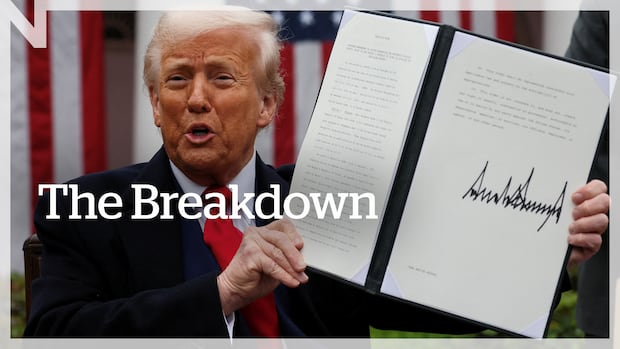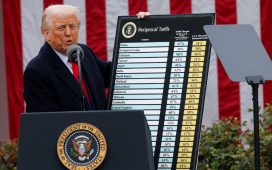Several Asian nations reeled on Thursday as they were hit with some of U.S. President Donald Trump’s heftiest tariffs, which now threaten the economies that have benefited from investment after Trump imposed levies on China during his first term.
Six of the nine Southeast Asian countries listed by Trump were slapped with much bigger-than-expected tariffs of between 32 per cent and 49 per cent on Wednesday. By comparison, the level for the European Union was 20 per cent, and Japan was at 24 per cent.
So far, none of the Southeast Asian nations have spoken of retaliatory tariffs.
“Ultimately dollar-for-dollar tariffs are not feasible if you’re a mid-sized or smaller economy, because then you’re in a situation where you’re significantly hurting yourself,” said Eric Miller, international trade consultant and president of Rideau Potomac Strategy Group, speaking to CBC’s Front Burner Wednesday evening.
Front Burner29:13Trump’s trade war goes global
Vietnam among the most exposed
For many of the countries, there may be no choice other than lobbying the U.S. directly for a more favourable rate.
Vietnam, for one, slapped with 46 per cent tariffs, called for talks with Washington in order to reconsider “unfair” duties.
It is among a number of heavy Asian exporters to the U.S. — having gained from the so-called “China plus one” strategy, whereby manufacturers shifted some production from China to nearby countries in the region — that will be under strain.
After months of dizzying tariff announcements and reversals, The National breaks down how we got to ‘Liberation Day’ and what we know about U.S. President Donald Trump’s motivation to upend global trade.
While the China plus one trend began years ago with concerns about labour costs, it was accelerated by geopolitical tensions between the two superpowers, which included Trump’s first-term tariffs directed at Beijing, as well recriminations about the origins of the COVID-19 pandemic.
Vietnam, where companies like Apple, Nike and Samsung Electronics have large manufacturing operations, appears particularly exposed. In addition to Nike, apparel companies Gap, Abercrombie, Adidas and Lululemon source between 27 and 40 per cent of their goods from Vietnam, according to a Bloombeg.com report.
Vietnam’s exports to the U.S., at $142 billion US last year, represented about 30 per cent of its gross domestic product.
Suppliers in Bangladesh’s garment industry, which counts Gap Inc. and Vans parent VF Corporation as clients, told Reuters they began seeking government support hours after Trump’s lightning bolt. Bangladesh was hit with a 37 per cent U.S. tariff.
The readymade garments industry is of existential importance to Bangladesh’s economy, accounting for more than 80 per cent of total export earnings, employing four million people and contributing roughly 10 per cent to its annual GDP.
Anwar-ul Alam Chowdhury of garment maker Evince — which counts Tommy Hilfiger and Levi Strauss & Co. as clients — says he fears India, which had been getting more queries from U.S. suppliers since last year’s political crisis in Bangladesh, will now benefit even more as it faces a slightly lower Trump tariff of 27 per cent.
Asian textile producer pain, Central American gain?
Another major South Asian casualty of Trump’s “reciprocal tariff” move is Sri Lanka, which now faces a 44 per cent tariff.
Around 40 per cent of Sri Lanka’s apparel exports are to the United States, which helped the island nation earn $1.9 billion US last year. Apparel is also Sri Lanka’s second largest foreign exchange earner; the sector employs 300,000 people.
Cambodia is facing tariffs of 49 per cent that will hurt its garment and footwear industries.
“The ultimate goal is to drive investment into the United States, said Miller, the international trade consultant.
Failing that, nearshoring could be also desired from Washington’s perspective. Miller noted the more modest tariffs applied to Honduras and El Salvador, where the textile and apparel industries are important job creators.
“In essence, the underlying incentive is to favour Central American apparel production,” he said.
Both Honduras and El Salvador, among other Latin American countries, appear to be co-operating with the Trump administration on another one of its stated priorities — driving out illegal migrants — potentially keeping them in good favour with the administration.
Tariffs, key executive order for China to face
For China, Trump’s tariff salvos could halt a largely export-led recovery underway since the COVID-19 was no longer considered an international emergency.
China was hit with a 34 per cent tariff, on top of the 20 per cent he previously imposed earlier this year, bringing the total new levies to 54 per cent and close to the 60 per cent figure Trump had threatened while on the campaign trail.
Chinese exporters, like those from other economies around the world, will face a 10 per cent baseline tariff, as part of the new 34 per cent levy, on almost all goods shipped to the world’s largest consumer economy from Saturday before the remaining, higher “reciprocal tariffs” take effect from April 9.
The average U.S. tariff on Chinese goods will be 76 per cent, according to Chad Brown, senior fellow at the Peterson Institute for International Economics and chief economist at the State Department for the last year of the Biden administration.
Despite, the eye-popping numbers, William Hurst, the Chong Hua Professor of Chinese Development at the University of Cambridge, said the impacts on China won’t be uniform.
“Trump’s tariffs certainly won’t help Chinese firms and will cause some real pain in some sectors, but they don’t make any definitive mark on the Chinese economy,” said Hurst.
“The American tariffs will spur more Chinese trade with other places, from Europe to Southeast Asia and Africa,” he added.
The uneven impact Hurst spoke of could felt in another measure Trump signed on Wednesday, which closed a trade loophole known as de minimis that has allowed low-value packages from China and Hong Kong to enter the U.S. duty free.
“The reason it’s gone away is because companies like Temu and Shein, which were founded in China, have become absolutely massive exporters direct from Chinese factories to U.S. consumers and all of these goods come in valued at less than $800,” Miller told CBC.
Taiwan feels superpower threats
For Taiwan — hit with a 32 per cent duty — Trump’s announcement came hours after the end of the latest round of Chinese war games around Taiwan. Beijing claims the territory as its own despite the objections of Taipei’s government.
Taiwan’s exports to and its large trade surplus with the United States have increased because of U.S. demand for semiconductors and artificial intelligence-related products, as well as Trump’s first-term tariffs and controls on China.
Taiwan is home to major chipmaker TSMC, which last month announced a new $100 billion investment in the United States.
The U.S. tariffs, however, do not apply to semiconductors.
Taiwan’s cabinet said in a statement that it would seek clarification and continue talks with Washington.









